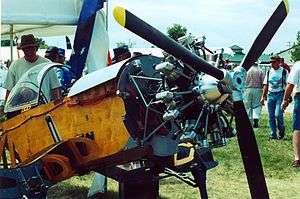W.A.R. F4U Corsair
The W.A.R. F4U Corsair is a 50% scale homebuilt replica of the Chance-Vought F4U Corsair Second World War carrier fighter.[1][2]
| W.A.R. F4U Corsair | |
|---|---|
 | |
| Corsair displayed with a Rotec R2800 engine while under construction. | |
| Role | Homebuilt aircraft |
| National origin | United States |
| Manufacturer | War Aircraft Replicas International, Inc. |
| Introduction | 1975 |
| Unit cost |
$9500 (1980) |
Design and development
The aircraft is a single place, single engine gull-wing design with retractable conventional landing gear. The F4U was the second completed aircraft in the W.A.R. series, with the first example displayed at the EAA airshow in 1975. The aircraft featured folding wings.[3]
Operational history
A WAR F4U built by Fred Bauer Jr. was featured as the cover plane on the January 1980 Popular Mechanics. The plane was built from plans that cost $145.[4]
Variants
Some versions were built using 125 hp (93 kW) Lycoming O-235 and 123 hp (92 kW) HCI radial engines.[5] One example was built using a Rotec R2800 radial engine.
Specifications (W.A.R. F4U Corsair)
Data from Jane's All The World's Aircraft 1988–89[6]
General characteristics
- Crew: 1
- Length: 16 ft 6 in (5.03 m)
- Wingspan: 20 ft 0 in (6.10 m)
- Height: 5 ft 0 in (1.52 m)
- Empty weight: 912 lb (414 kg)
- Gross weight: 1,200 lb (544 kg)
- Powerplant: 1 × Continental O-200-A air-cooled flat-four, 100 hp (75 kW)
Performance
- Maximum speed: 147 kn (169 mph, 272 km/h)
- Cruise speed: 105 kn (121 mph, 195 km/h)
- Range: 347 nmi (399 mi, 643 km)
- Rate of climb: 1,400 ft/min (7.1 m/s)
Notes
- Downey, Julia: 1999 Plans Aircraft Directory, Kitplanes, Volume 16, Number 1, January 1999, page 71. Primedia Publications. ISSN 0891-1851
- Purdy, Don: AeroCrafter - Homebuilt Aircraft Sourcebook, page 291-2. BAI Communications. ISBN 0-9636409-4-1
- "Oshkosh 75". Sport Aviation. October 1975.
- Sheldon Gallagher and Howard Levy (January 1980). "7 exciting new sports planes you can build". Popular Mechanics. p. 76.
- WAR F4U Corsair
- Taylor 1988, p. 612.
References
- Taylor, John W. R. Jane's All The World's Aircraft 1988–89. Coulsdon, UK:Jane's Defence Data, 1988. ISBN 0-7106-0867-5.
- Gallager, Sheldon M.; Levy, Howard (January 1980). "7 exciting new sports planes you can build". Popular Mechanics. Vol. 153 no. 1. pp. 76–79.
- Gallager, Sheldon M. (January 1981). "21 exciting new sports planes you can build". Popular Mechanics. 155 (1): 74–77.
- Kitplanes. Aug 2001. Missing or empty
|title=(help) - Recreational Flyer. Nov 1988. Missing or empty
|title=(help) - Recreational Flyer. Fall 1987. Missing or empty
|title=(help)
- Popular Flying. Nov 1981. Missing or empty
|title=(help) - Homebuilt Aircraft. Nov 1980. Missing or empty
|title=(help)
External links
| Wikimedia Commons has media related to W.A.R. F4U Corsair. |